|
|
||
|
One of the most critical technology required for the realization of 6G would be to implement the hardware working at Subteraherz and Teraherts range in Electronic way. The hardware working in this frequency range had traditionally been implemented in Photonics but it is less likely that the photonics solution can easily been utilized in mobile commuincation system especially on UE implementation. These extremely high frequencies, ranging from 100 GHz to 1 Thz, offer ultra-high data rates, ultra-low latency, and unprecedented bandwidth capacity, making them essential for future wireless communication systems. However, the challenge lies in the fact that traditional implementations in this frequency range have predominantly relied on photonics-based solutions. While photonic technologies provide excellent performance in terms of speed and efficiency, they are not easily adaptable for mobile communication systems, especially for User Equipment (UE), which requires compact, power-efficient, and cost-effective hardware solutions. The electronic implementation of subterahertz and terahertz hardware is a relatively new area of research, but rapid advancements in semiconductor technology, material science, and circuit design are paving the way for practical realizations. As the industry moves toward 6G, overcoming these hardware challenges will be crucial for ensuring widespread adoption, energy efficiency, and seamless integration into mobile and IoT ecosystems. Realization of hardware in this range with electronic technology is relatively new area but I think it is progressing rapidly and this note is to follow up the researchs on this field (i.e, electrical implementation of Subterahertz / Teraherts Hardware).
Key Considerations in Subterahertz/Terahertz Hardware DevelopmentIf 6G pushes toward higher frequencies for increased capacity and performance, addressing the challenges in subterahertz and terahertz hardware implementation is essential. While the shift from photonics to electronic-based solutions introduces significant technical hurdles, advancements in semiconductor materials, RF circuit design, and signal processing techniques are making this transition increasingly viable. Continued research and development in these key areas will shape the future of 6G communication systems, enabling ultra-fast, low-latency, and highly efficient wireless networks for the next generation of connectivity.
This note will highlight key areas of research and development in this field:
From Conventional to Native Terahertz FrontendFollowing is brief summary showing the pathways to realize subteraherts and terahertz frontend based on this paper (Ref [1]). I think it would be the best if we find solutions to achieve subteraherts and terahertz frontend using the section [A] technology, but at least as of now (Sep 2022) it doesn't seem to be the case and putting more focus on section [B] technology as an alternative.
Semi Conductor ReadinessUp until 5G implementation, we didn't have to worry too much of this level of readiness : Semi Conductor/Transistor level readiness since the technology in semi conductor was mostly going ahead of Wireless communication technology requirement and the semicoductor technology to meet 5G requirement was available before 5G requirement was finalized. But the situation seems to be different in 6G. The semiconductor technology available now seems to be far from being ready to meet 6G requirement. Therefore, we would need to keep close eye on the technical evolution in this aready as we form the detailed 6G requirement and check the feasibility of achieving those requirement. Following is the summary of status on the semiconductor technologies that would be critical to implement the electrical components for 6G.
Source : Hera-X : Deliverable D2.1 Towards Tbps Communications in 6G: Use Cases and Gap Analysis(Ref [2])
Source : ETSI GR mWT 022 V1.1.1 (2021-04) (Ref [3]) Highligts to note : Followings are some of the highlights that you would notice from the data shown above.
Some important parameters to be noted for the performance / characteristics of this technology are as follows :
It is stated as follows (Ref[4]) Although there are already technologies that can achieve operation in the range of 1001,000 GHz, the implementation of any larger system like an RF transceiver will be much more difficult than for 5G frequencies in the lower mmW region. One must remember that even at lower mmW frequencies, it is impossible to achieve similar performance to frequencies below 6 GHz with the same power consumption. The limitations arise from physics and the boundaries of different semiconductor technologies.
It is stated as follows in (Ref [5]) : Fundamentally, semiconductor device performance will need to be a minimum of 3x to 5x better than the wireless carrier frequency to implement radios with acceptable range, power dissipation, and link margin characteristics. For example, utilization of the sub-THz 100-300GHz spectrum will therefore require semiconductor technologies with 0.5THz to > 1THz performance. Silicon and III-V semiconductors are candidate technologies, with advances in SiGe and InP promising >1THz performance.
A demo with 140 Ghz RF IC(2022) : @ 20:56 of 6G@UT Forum - KEYNOTE - Road to 6G: Radio Technology Evolution
Considerations on the overal Radio Front EndAs the technologies for individual transistor evolves to meet the 6G requirement, we have to re-evaluate those technologies in terms of the structure of the whole front end. The overall sturcture of transmiter and reciver front end can be illustrated as below and we need to check if the technology for each segment of the frontend is ready and also need to consider how to integrate each of the segment to build the whole frontend module.
AD ConverterRegarding AD Converters, generally several questions as follows are the important ones to be answered.
In general, maximum sampling rate would be limited by the available semiconductor technology, the bit resolution would vary depending on processing performance and the power consumption would be affected by sampling rate and bit resolution. A common way to estimate a ADC taking all three factors is to use FOM (Figure of Merits) as described below.
According to Ref [1], state-of-the-art DACs able to sample at frequencies in excess of 100 Giga-samples-per-second (GSaps) have been experimentally demonstrated. For example, two 128 GSaps DACs are multiplexed to effectively sample at 256 GSaps. This translates to a signal bandwidth of at most 128 GHz with 2bit resolution Noise Factors on Rx ChainAs described above, the major issue on Tx chain is how to develop Power Amplifiers that can pump up enough power. What is the major issue (critical factor) on Rx chain. It is how to decrease the noise factor of the whole reciever chain. The estimation of noise factor on reciever chain can be summarized as below based on Hera-X : Deliverable D2.1 Towards Tbps Communications in 6G: Use Cases and Gap Analysis (Ref [2])
AntennaAs you may understand, the size of the most of RF components is inversally proportional to the frequency of the operating frequency. In other words, the size of the RF components gets smaller as the operating frequency increases. Antenna elements (single antenna) would be the components that best complies to this rule. Considering very high operating frequency of 6G, we would easily guess that the size of an antenna elements would be very small. Since antenna is such a important and critical components of RF chain, I wrote a separte note for this component here. Reference[1] Terahertz Band Communication: An Old Problem Revisited and Research Directions for the Next Decade [2] Hera-X : Deliverable D2.1 Towards Tbps Communications in 6G: Use Cases and Gap Analysis [3] ETSI GR mWT 022 V1.1.1 (2021-04) [4] WHITE PAPER ON RF ENABLING 6G OPPORTUNITIES AND CHALLENGES FROM TECHNOLOGY TO SPECTRUM [6] Enhancing Sub-Terahertz RF EDA Workflows for 6G Challenges - Microwave Journal (Jul 2023) YouTube
|
||






